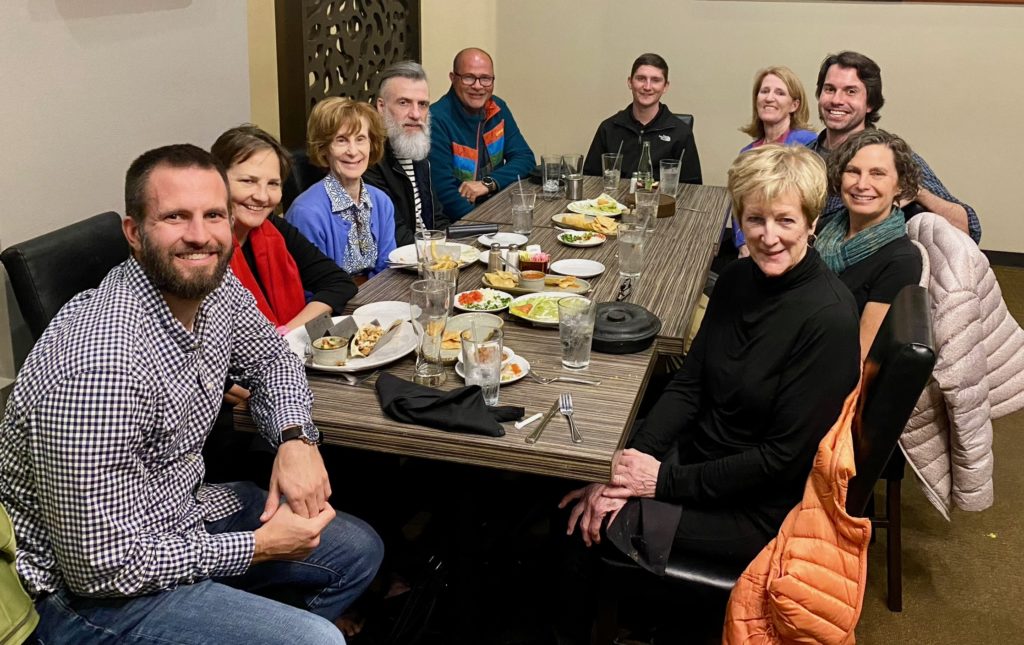ISJ Essay: To Witness and Accompany

Anyone who’s ever searched for a rainbow knows that’s not the way to go about it. You don’t find them; they find you.
When six of us from Ignatian Social Justice left at the end of January for a week at the US-Mexico border, I honestly wasn’t quite sure what we were looking for or exactly what we were going to find, but I knew that it was time for me to learn more about one of the greatest humanitarian crisis our world faces. Every corner of the world is affected by some type of migration crisis. Our response to these displacements shapes our countries, communities, and humanity.
Our overall goal, as I understood it was to ‘witness and accompany.’ What would that look like?
In Reynosa, Mexico, we brought a carload of toys and coloring kits for the children living with their mothers in dormitory-style rooms. They all wore everything they could get their hands on against the cold winter da: sockss and sandals, a snowsuit, a sweater, or a light coat over a t-shirt.
Later that day, in the Senda 2 camp, we saw many people living in plastic-covered tents in tidy rows. A group of Mormon volunteers were building casitas that housed three and four families in one-room structures. Everywhere the migrants were organizing themselves into work units—caulking around the casitas, securing the gate, cooking for the thousands in impossibly large pots in the open kitchen, cleaning the latrines, distributing donated diapers, cleaning supplies, and food. When we asked how they got people to volunteer for the less savory jobs, one responded with a sly smile, “We unplug the phone chargers until someone volunteers.” The phones are their lifelines. They make hasty phone calls to loved ones at home. They WhatsApp their sponsors in the US. They load and reload the new CBP (Customs and Border Patrol) app, which God-willing will one day tell them they are confirmed for an appointment at the border—the answer to their prayers.
In a car loaded with rice and corn flour, we joined a Baptist pastor in Matamoros, Mexico. No walls surrounded this camp. The ground was uneven; there were muddy puddles though the last rain was days before, and the ‘tents’ were often made from bits of plastic and tarp. Amenities include four water stations, a handful of port-o-potties, and makeshift showers for thousands of migrants. After the food was gone, a line formed for the cardboard boxes the rice came in. They’re used to sleeping on to protect them from moisture, uneven terrain, and filth. Plus, the kids found them highly entertaining.
These are just a few of the visits we made.
Oh, and the rainbow appeared. Twice.
Working in Brownsville with the newly arrived, a couple recognized us from the camp. They fell into our arms like long-lost friends. We literally danced and laughed and got them in contact with volunteers in DC.
Then, on our last day, when there was nothing left to do but fly home and ponder all that we’d seen and heard, we noticed the lost and confused migrants trying to find their way through Houston airport. We gathered them, and bought them breakfast. We held hands, and explained gates, airport names, and boarding groups. Until finally, at baggage claim in LaGuardia, we watched them fall into the arms of their family members, sobbing with tears of joy and relief.
Back to the original question of what we were doing. We did witness and accompany. We saw lots of pieces of the puzzle—both sides of the border.
Unaccompanied minors, single moms, and young solo men. We heard heart-rending stories alongside humor, joy, and faith. The more we understood, the more each story revealed its uniqueness. We came to know people, religious and otherwise, dedicating much of their lives to tending to those in dire circumstances. Altogether it was humbling and eye-opening—a call to action.
— Regan Orillac
